Aviary
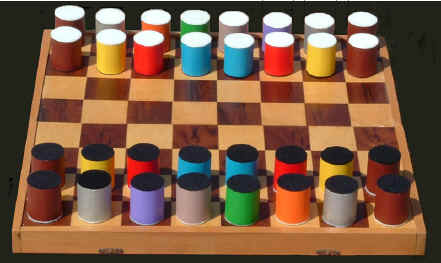
Introduction
I invented this about 14 years ago. What makes this variation unusual, is the fact that the various pieces are not distinguished from one another by shape or symbol, but by color. Each disk (or "Bird") has a black spot on one side and a white on the other, that determine which player it belongs to. Like Shogi, when a piece is captured, it then becomes the property of the capturer, and can be flipped over to then be re-entered on to the board to be part of his or her army.
The fact that this game has no long-range pieces might seem a bit off-putting at first, but once the game starts, it's rather amazing just how fast the center of the board becomes a clash of winged armies. Although most games that consist of pieces that can only move two spaces at a time are usually played on smaller boards, the fact that throughout most of the game, all 32 pieces are either on the board, or waiting to be dropped there at any time, justifies the full size 8x8 board.
There are no equivalents of pawns in ths game, and since the Shogi method of regaining pieces is always in effect, they are not needed. I find that this makes for a much less cluttered playing field.
The final unusual twist in this game, is the fact that each player starts out with not one, but two "Kings" (Sparrows) that must be captured, in order to win the game. This might also seem a bit daunting at first, but it's also a bit calming to know that all is not lost if one loses a silver piece, because it can be regained. On to the rules!
Pieces
First of all, it is very easy to remember the names of all the birds, simply because the first letter of all their names is also (more or less) the first letter of the respective color that represents them. Because each bird's color/name begins with a different letter from all the others, taking notation when playing this game, is especially easy:Bluejay=Blue
Robin=Red
Canary=Canary Yellow
Owl=Orange
Gull=Green
Pigeon=Purple
Tern=Tan
Woodpecker=Wood
Sparrow=Silver
The Opening Setup
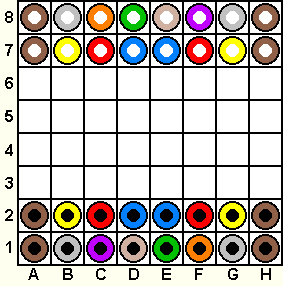
White Birds: Woodpeckers A-7, A-8, H-7, H-8 Sparrows B-8, G-8 Owl C-8 Gull D-8 Tern E-8 Pigeon F-8 Canaries B-7, G-7 Robins C-7, F-7 Bluejays D-7, E-7
Black Birds: Woodpeckers A-1, A-2, H-1, H-2 Sparrows B-1, G-1 Pigeon, C-1 Tern D-1 Gull E-1 Owl F-1 Canaries B-2, G-2 Robins C-2 F-2 Bluejays D-2, E-2
How The Pieces Move
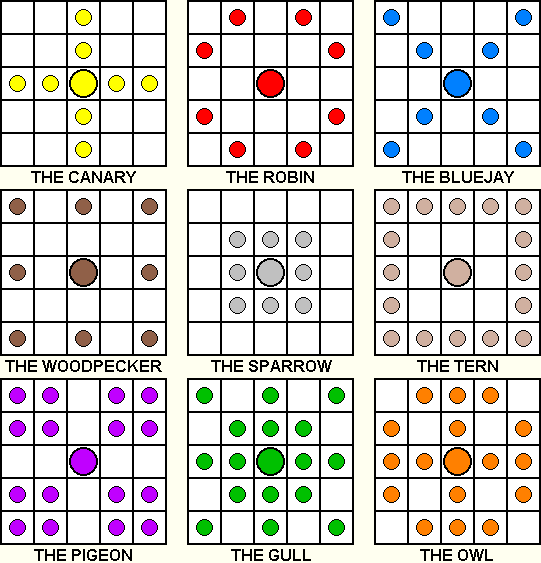
The Canary moves one or two
spaces orthogonally in all four directions. The Bluejay
moves one or two spaces diagonally in all four directions.
The Robin moves like the Knight in
Standard Chess, except that it's possible to block it (more on that later). The
Woodpecker moves two spaces orthogonally
or diagonally in all eight directions. The Sparrow moves one space in all eight directions. The
Tern combines the movements of the Robin
and the Woodpecker.
Here's where it gets interesting. If you know anything about
mixing colors, you know that Red and Blue make Purple, therefore, the Pigeon combines the moves of the Robin and the Bluejay. Because Blue and Yellow make Green, the Gull combines the movements of the Bluejay and the Canary. Finally, Yellow and Red make Orange,
so the Owl moves like a combination of
the Canary and the Robin. Obviously, this game can also be a fine
educational tool for teaching kids how to mix paints. Each Player starts out
with twelve minor birds (the primary colored pieces, plus the Sparrows and Woodpeckers) that have a choice of eight
spaces they can move to from any centrally located cell. And, each player also
starts out with four major birds (the secondary colors, plus the Tern) that each have a choice of sixteen
different potential destinations per turn.
Jumping, Blocking and Capturing
Although it really doesn't matter who initiates, players who are used to FIDE chess, might wish to retain the rule about white moving the first piece. If a player wishes to move a bird two spaces vertically, diagonally, or knight-like, and one of his other birds is resting on the square in between, the intervening bird can be jumped over. A player cannot, however, jump over one of his/her opponent's birds. This rule applies throughout the duration of the game. Therefore, if the player with the White birds wishes to move one of his major birds on the first turn, he/she has plenty of options. The Owl can move to 6-B, 6-C or 6-D (see the set-up illustration above). The Gull can move to 6-B, 6-D or 6-F. The Tern has the most options, being able to move to 6-C, 6-D, 6-E, 6-F or 6-G. Finally, the Pigeon can move to 6-D, 6-E, 6-G or 6-H.Capturing an opponent's bird is done by displacement. If a player is threatening an opposing bird from two spaces away, the opponent can protect his bird by moving another bird on to the square in between. As a matter of fact, if the threatening bird is either a Woodpecker or a Tern, the intervening bird isn't even vulnerable to capture (at least not by the threatening bird). The illustration below, gives a couple of examples:
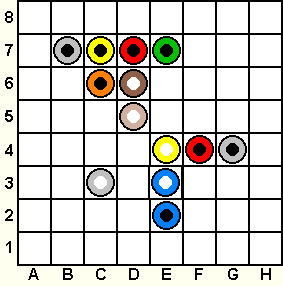
Let us
assume it is White's turn to move. The Tern on 5-D can easily jump over the
friendly Woodpecker on 6-D to capture the Gull on 7-E, the Robin on 7-D, or the
Canary on 7-C. For that matter, it can also capture the Robin on 4-F. It is
not capable of capturing the Sparrow on 7-B, because of the opposing Owl
on 6-C, blocking it's way. For that same reason, the Canary on 4-E may capture
the Bluejay on 2-E, but it cannot capture the Sparrow on 4-G. It can,
however, capture the Robin on 4-F that is preventing it from capturing the
Sparrow. If it does this, it then really will be threatening the Sparrow
on 4-G!
Blocking the Robin
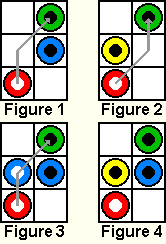
Unlike the Knight in FIDE Chess, the Robin in Aviary can be
blocked, but it takes two opposing birds to do it. This also applies to
the Pigeon, the Owl or the Tern, whenever they move like the Robin. The Robin
either moves one space orthogonally then one space diagonally, or vice versa.
Figure #1 illustrates how placing an opposing bird in the intervening diagonal
square is not enough to prevent the White Robin from capturing the Black Gull
via the orthogonal-first route. Figure #2 demonstrates the same principle in
reverse. Figure #3 is yet another demonstration of how a bird can easily jump
over one of it's comrades. Only in Figure #4, is the Robin completely sealed off
from the opponent's Gull (and for that matter, being threatened by both of the
intervening birds).
Re-entering Captured Birds
Whenever one captures an opponent's bird, it becomes part of the capturer's off-the-board arsenal. By flipping it over, the bird changes from black to white or vice versa, and is ready to be parachuted back onto the board Shogi-style at any time. As a courtesy to the opponent, all captured Birds should be stored next to the board where they are clearly visible, making it easier for both players to plan their respective strategies. When a Bird is returned to the board, the act of doing so counts as one move. It can be placed on any square, as long as it is unoccupied. Note that when an opponent is down to one Sparrow, this is a very common way of facilitating a checkmate.The Sparrows
Whenever a Sparrow is threatened, the offending player must always say "Check." Unlike FIDE Chess, however, unless one is down to his or her last Sparrow, moving it out of harm's way is not mandatory, nor is it obligatory for the offending player to capture it after it has not been moved, although there are very few situations that would render either of those decisions wise. If one has only a single Sparrow on the board, and one (or two) in the off-the-board arsenal, and the former is captured by the opponent, another Sparrow must immediately be re-entered on to the board. In other words, for obvious reasons, each player must always maintain at least one Sparrow on the board throughout the duration of the game.Winning The Game
A checkmate occurrs in very much the same way it does in FIDE Chess. If a player is down to his or her last Sparrow, and the opponent puts it in check, and it has no place to move where it isn't in check, the game is over. There are alot more creative ways to cause a checkmate than one would think, without the help of any long-range pieces. The illustrations below, demonstrate some interesting examples:
Figures 1 through 4 illustrate the fact that all one needs are two major birds to achieve a mid-board checkmate. Figure 5 demonstrates how, when a Sparrow is on an edge square, it's possible to checkmate it with two minor birds. Finally, Figure 6 shows how to win the game using only one bird. Note that none of these positions are possible with standard Chess pieces.
Board Design
The reason all of the images that have so far appeared in these instructions have consisted of nothing but white squares is merely because that is the easiest way to present the movements of the different birds for the first time. However, like any game that features Bishop-like pieces that can only move on half of the board's 64 squares, there is a bit of a visual convenience in utilizing a checked board. It makes it a little easier to determine the status of those pieces (in this case, the Bluejays), and what other pieces they are capable of interacting with at any given moment. Aviary has the additional burden of the Woodpeckers, each of which is only capable of occupying a quarter of the board's 64 squares (which is why the players start out with four of them). It is for this reason that if one is going to construct a playing board, I recommend that it look something like one of these two designs, or something similar: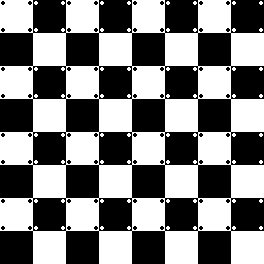

This gives the players four distinct types of squares (black, white, black with dots/stripes, white with dots/stripes). This way, one is able to determine at a glance, what spaces across the board, any given Woodpecker is capable of landing on.
As a final note on the subject, I'd just like to mention that this game is a natural for portable magnetic boards. The birds can be made from small wooden disks (that are easily available in most arts and crafts shops) and some paint. Simply glue a small circular magnet painted black on one side, and one painted white on the other.
